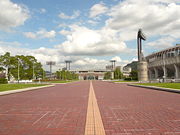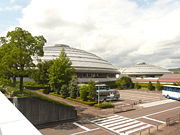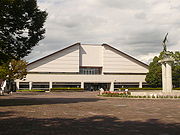
Gifu Memorial Center
Encyclopedia

Gifu, Gifu
is a city located in the south-central portion of Gifu Prefecture, Japan, and serves as the prefectural capital. The city has played an important role in Japan's history because of its location in the middle of the country. During the Sengoku period, various warlords, including Oda Nobunaga, used...
, Gifu Prefecture
Gifu Prefecture
is a prefecture located in the Chūbu region of central Japan. Its capital is the city of Gifu.Located in the center of Japan, it has long played an important part as the crossroads of Japan, connecting the east to the west through such routes as the Nakasendō...
, Japan
Japan
Japan is an island nation in East Asia. Located in the Pacific Ocean, it lies to the east of the Sea of Japan, China, North Korea, South Korea and Russia, stretching from the Sea of Okhotsk in the north to the East China Sea and Taiwan in the south...
. It is a prefectural facility and its purpose is to promote sports and other events within the prefecture.
Along with the Nagaragawa Convention Center
Nagaragawa Convention Center
The is a multi-purpose convention center in the city of Gifu, Gifu Prefecture, Japan. The name literally translates to Nagara River International Convention Center, but the official English translation drops "international."...
, the Nagaragawa Sports Plaza and Mirai Hall, it is part of the World Event and Convention Complex Gifu.
History
The Memorial Center is an athletic park run by Gifu Prefecture and is located on the north bank of the Nagara RiverNagara River
The has its source in the city of Gujō, Gifu Prefecture, and its mouth in the city of Kuwana, Mie Prefecture, Japan. Along with the Kiso River and Ibi River, the Nagara River is one of the Kiso Three Rivers of the Nōbi Plain. Previously, the river was named Sunomata River . With a length of , it...
. Its site was originally developed for the National Sports Festival
National Sports Festival of Japan
is the national premier sports event of Japan. The abbreviated name is Kokutai . The 65th National Sports Festival of Japan was held in October 2010 in Chiba Prefecture.- Emperor's Cup and Empress Cup Champions :...
that was held in Gifu in 1965. The site also includes the Gifu Prefectural Baseball Stadium
Gifu Prefectural Baseball Stadium
Gifu Prefectural Baseball Stadium is a multi-purpose stadium in Gifu, Japan. It is currently used mostly for baseball matches. The stadium was originally opened in 1930 and has a capacity of 30,000 spectators....
and, only a few hundred meters from there, the former location of the Gifu Correctional Facility. When the correctional facility was moved to a different location, it was decided that the facilities should be converted to help promote sports in the area. The site was then used to host the Gifu Future Watch '88 Exposition, before full construction of the present-day Memorial Center began. In 1990, construction began on the track and field facilities, which was soon followed by other sport-specific facilities.
Major facilities
Many of the Memorial Centers facilities are connected by the San San Deck (サンサンデッキ San San Dekki), a raised pedestrian walkway that runs through the center of the complex. Some other buildings that are connected by the deck include the Management Building (本館 Honkan), which houses staff offices, training rooms and a gymnasium; as well as the city-supported Green Space (芝生広場 Shibafu Hiroba). To the north of the complex is the Youth Play Area (幼児児童広場 Yōji Jidō Hiroba), which includes a replica of a dinosaur skeleton.Multipurpose facilities

Modern sports
The Nagaragawa Stadium (長良川競技場 Nagaragawa Kyōgi-jō) has an eight-lane, 400-meter outdoor track that surrounds a natural grass field. Since 1992, the track has served as the start and finish line for the All Japan Businesswomen EkidenEkiden
is a term referring to a long-distance relay running race, typically on roads. The Japanese term originally referred to a post-horse or stagecoach which transmitted communication by stages.-History:...
, in addition to various other track events. The inner pitch can be used for rugby, soccer and field hockey. Until 2001, it served as the home pitch for the Nagoya Grampus Eight
Nagoya Grampus Eight
are a Japanese association football club that play in the J. League. Based in Nagoya, Aichi Prefecture and originally founded as the company team of the Toyota Motor Corp...
and, currently, it is used as the home pitch for F.C. Gifu
F.C. Gifu
is a Japanese football club based in Gifu Prefecture. Gifu were promoted to J. League Division 2 for the first time at the end of 2007, and played their first season in 2008 where they finished 13th. The team colour is green.-History:...
, which entered the J. League
J. League
The or is the top division of and is the top professional association football league in Japan. It is one of the most successful leagues in Asian club football and the only league given top class 'A' ranking by the AFC. Currently, J. League Division 1 is the first level of the Japanese...
in 2008. This track and field is supported by the smaller Supplemental Athletic Field (補助競技場 Hojo Kyōgi-jō) just beside it. The supplemental field has a six-lane, 300-meter track that is often used for warm ups and practices. The Nagaragawa Ball Field (長良川球技メドウ Nagaragawa Kyūjō Medō) also serves as host for various field sports.

Chunichi Dragons
The are a professional baseball team based in Nagoya, the chief city in the Chubu region of Japan. The team is in the Central League. They won the 2007 Japan Series and 2007 Asia Series.-History:...
play host at the stadium for one game. The stadium has a capacity for approximately 30,000 spectators.
Other sports facilities include the Nagaragawa Swimming Plaza (長良川スイミングプラザ Nagaragawa Suimingu Puraza) and the Nagaragawa Tennis Plaza (長良川テニスプラザ Nagaragawa Tenisu Puraza). The swimming plaza consists of a 50-meter, nine-lane outdoor pool and a 25-meter, seven-lane indoor pool, as well as an outdoor pool for synchronized swimming. The tennis plaza holds one center court, in addition to 16 other courts, all of which are clay or artificial grass. Both of these plazas are open to the general public, though they are occasionally closed for both amateur and professional tournaments.
Traditional sports

Judo
is a modern martial art and combat sport created in Japan in 1882 by Jigoro Kano. Its most prominent feature is its competitive element, where the object is to either throw or takedown one's opponent to the ground, immobilize or otherwise subdue one's opponent with a grappling maneuver, or force an...
and kendo
Kendo
, meaning "Way of The Sword", is a modern Japanese martial art of sword-fighting based on traditional Japanese swordsmanship, or kenjutsu.Kendo is a physically and mentally challenging activity that combines strong martial arts values with sport-like physical elements.-Practitioners:Practitioners...
. The Sumo Grounds (相撲場 Sumō-jō) only offer one ring in which sumo
Sumo
is a competitive full-contact sport where a wrestler attempts to force another wrestler out of a circular ring or to touch the ground with anything other than the soles of the feet. The sport originated in Japan, the only country where it is practiced professionally...
wrestlers can face off, but provides seating for over 150 viewers. Also, the Nagaragawa Kyūdō Grounds (長良川弓道場 Nagaragawa Kyūdō-jō) allows up to six participants to compete in kyūdō
Kyudo
, literally meaning "way of the bow", is the Japanese art of archery. It is a modern Japanese martial art and practitioners are known as .It is estimated that there are approximately half a million practitioners of kyudo today....
competitions.
Access
- From JR Gifu StationGifu Stationis a train station operated by Central Japan Railway Company and is located in the heart of Gifu, Gifu Prefecture, Japan. Along with Meitetsu Gifu Station, it is one of the two main rail stations in Gifu City.-History:...
(Bus Platform 10) or Meitetsu Gifu StationMeitetsu Gifu Stationis the main terminal of Nagoya Railroad in the city of Gifu, Gifu Prefecture, Japan. It is one of the two major train stations of the city along with JR Gifu Station....
(Bus Platform 5), board a bus on the Mitahora-danchi Line. Get off the bus at "Gifu Memoriaru Sentā, Seimon-mae" or "Gifu Memoriaru Sentā-mae." It takes approximately 17 minutes. - From JR Gifu Station (Bus Platform 9), board a bus on the Nagara Iryō Line. Get off the bus at "Gifu Memoriaru Sentā-mae." It takes approximately 20 minutes.

